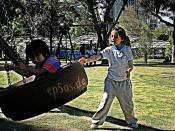Between 7:00 am to 8:00 am, children arrived their school and said good-bye their parents. Then children started to their school activities such as learning something new from teacher, playing with each other and having lunch. Especially in Japan, preschool is associated with temple, just as many U.S preschool relate with the church. These general ways were similar preschool experience across cultures. However, there are two different ways between Japan/China and U.S as we watched video. Japanese and Chinese preschools usually socialized children towards collectivism. For example in Japan, children were interacting between older and younger. It means that usually older children take care of younger children when their free time to play. Also, teacher did not get involved when children got trouble with each other. Teacher just leaved children that they have to solve problem by themselves. About in China, toilet behavior was also can be example of collectivism.
Children used toilet all together at the same time. U.S and Japanese could not understand this behavior but Chinese coordinator mentioned that it is good for regulate body on children.
On the other hand, U.S preschool socialized children toward individualism. They empathized self- expression of each child. Through learning period, children developed their abilities. Also unlikely in Japan, U.S. teacher controlled individually that a student who refuses to clean up toys.
Lastly, when shown the video footage in all three countries, each country's teachers critique other countries passively than their own country. For example, Japanese critique about class rate, small class like in U.S. will be good for teacher but not for student. Because children need to be interact many other children. Then, they learned bout how to deal with with others. But in U.S teacher responded that even though Japan and China have nice material for children such as origami and puzzle, they did not have chance to how to play with that. It means that every child did the same thing during the class activities. In U.S, they have choice that whatever children want to do. Thus, ethnocentrism can occur at any countries and any stage of the research process. We try to get rid of this bias between other cultures.


